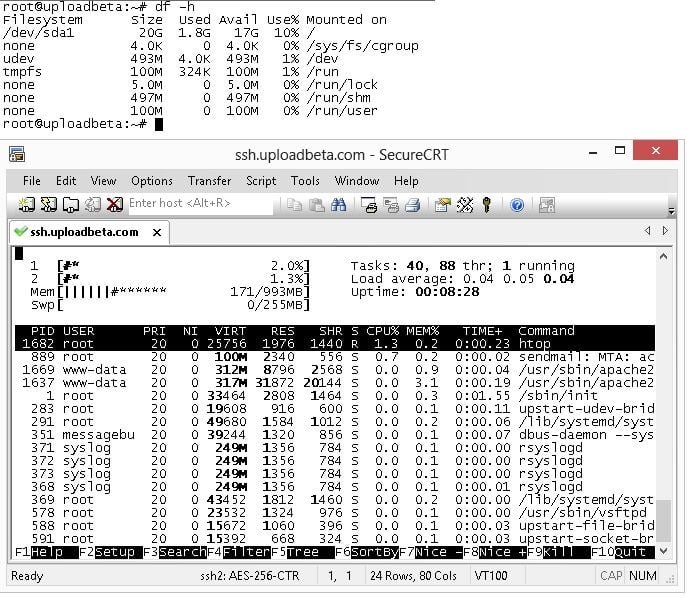As you may know, my three websites are hosted on a VPS starter package from QuickHostUK – Unlimited Web Hosting. It costs 7 pounds per month, and what I get is pretty much enough for small websites. The VPS starter provides 1 core, 512MB RAM and 10GB HDD. The CPU is not that bad.
root@uploadbeta:~# cat /proc/cpuinfo | head processor : 0 vendor_id : GenuineIntel cpu family : 6 model : 23 model name : Intel(R) Xeon(R) CPU E5440 @ 2.83GHz stepping : 6 microcode : 0x1 cpu MHz : 2826.278 cache size : 4096 KB physical id : 0
A few days ago, everything was fine, the server status was ok before I went to sleep, after I woke up, the MySQL database was down but apparently the Apache2 server was OK and therefore, when I typed in my URL, it gives a ‘cannot connect to MySQL server’ kinda error. The SSH login was fine. but apparently the MySQL background process was missing. I had to start it by:
sudo service mysql start
In order to figure out what happened and prevent same things in the future, I looked into the /var/log/mysql folder for log files. and below are the logged messages:
1 [Warning] Using unique option prefix myisam-recover instead of myisam-recover-options is deprecated and will be removed in a future release. Please use the full name instead. 1 [Note] Plugin 'FEDERATED' is disabled. 1 InnoDB: The InnoDB memory heap is disabled 1 InnoDB: Mutexes and rw_locks use GCC atomic builtins 1 InnoDB: Compressed tables use zlib 1.2.8 1 InnoDB: Using Linux native AIO 1 InnoDB: Initializing buffer pool, size = 128.0M InnoDB: mmap(137363456 bytes) failed; errno 12 1 InnoDB: Completed initialization of buffer pool 1 InnoDB: Fatal error: cannot allocate memory for the buffer pool 1 [ERROR] Plugin 'InnoDB' init function returned error. 1 [ERROR] Plugin 'InnoDB' registration as a STORAGE ENGINE failed. 1 [ERROR] Unknown/unsupported storage engine: InnoDB 1 [ERROR] Aborting 1 [Note] /usr/sbin/mysqld: Shutdown complete 2 [Warning] Using unique option prefix myisam-recover instead of myisam-recover-options is deprecated and will be removed in a future release. Please use the full name instead. 2 [Note] Plugin 'FEDERATED' is disabled. 2 InnoDB: The InnoDB memory heap is disabled 2 InnoDB: Mutexes and rw_locks use GCC atomic builtins 2 InnoDB: Compressed tables use zlib 1.2.8 2 InnoDB: Using Linux native AIO 2 InnoDB: Initializing buffer pool, size = 128.0M InnoDB: mmap(137363456 bytes) failed; errno 12 2 InnoDB: Completed initialization of buffer pool 2 InnoDB: Fatal error: cannot allocate memory for the buffer pool 2 [ERROR] Plugin 'InnoDB' init function returned error. 2 [ERROR] Plugin 'InnoDB' registration as a STORAGE ENGINE failed. 2 [ERROR] Unknown/unsupported storage engine: InnoDB 2 [ERROR] Aborting 2 [Note] /usr/sbin/mysqld: Shutdown complete
So, it seems that the 512MB memory is not enough and the MySQL aborted because of this.
Solutions
As it can be seen in the log files, the the InnoDB buffer pool size is set to 128MB. Therefore, one obvious solution is to change this to e.g. 64MB in the my.cnf.
root@uploadbeta:~# locate my.cnf /etc/mysql/my.cnf
The second solution is to upgrade the VPS, which I did. I later upgraded the VPS to business package, which offers 1G RAM, 2 cores and 20GB HDD (twice).
root@uploadbeta:~# free -m
total used free shared buffers cached
Mem: 993 827 166 64 105 485
-/+ buffers/cache: 237 756
Swap: 255 0 255
root@uploadbeta:~# cat /proc/meminfo | head
MemTotal: 1017832 kB
MemFree: 156428 kB
Buffers: 107540 kB
Cached: 497004 kB
SwapCached: 0 kB
Active: 491892 kB
Inactive: 303588 kB
Active(anon): 212108 kB
Inactive(anon): 44740 kB
Active(file): 279784 kB
The other solution is to enable the swap. The swap are HDD file systems that are used to copy less-frequently used data onto so that more memory than physical RAM can be used. To see if there are currently used swap files, use the command sudo swapon -s, an empty file list suggests that currently the swap is disabled.
Filename Type Size Used Priority
Now, you can use df -h command to see the disk system usages.
root@uploadbeta:~# df -h Filesystem Size Used Avail Use% Mounted on /dev/sda1 20G 1.9G 17G 10% / none 4.0K 0 4.0K 0% /sys/fs/cgroup udev 493M 4.0K 493M 1% /dev tmpfs 100M 324K 100M 1% /run none 5.0M 0 5.0M 0% /run/lock none 497M 0 497M 0% /run/shm none 100M 0 100M 0% /run/user
So, we can decide how much space is for the swap system. Suppose, we want to allocate 256MB for swapfile.
sudo dd if=/dev/zero of=/swapfile bs=1024 count=256k
Now, the of specifies the output file path, which is /swapfile and you can change this path if you don’t like it. The next thing is to make it a proper swap file, by using command:
sudo mkswap /swapfile
It will show up something like this:
Setting up swapspace version 1, size = 262140 KiB no label, UUID=104c4535-5ac5-43f3-aab3-cfbd653fe8ab
Now, we can finish this by enabling it.
sudo swapon /swapfile
Let us see if it is on:
root@uploadbeta:~# swapon -s Filename Type Size Used Priority /swapfile file 262140 0 -1
This is on until the VPS restarts, so to enable it everytime, you should set this up in the fstab
sudo vim /etc/fstab
And add the following line:
/swapfile none swap sw 0 0
Finally, we set the swapness to 10 to prevent out-of-memory crashes.
echo 10 | sudo tee /proc/sys/vm/swappiness echo vm.swappiness = 10 | sudo tee -a /etc/sysctl.conf
For security purposes, you should also set the right file permission otherwise, it may be world-wide writeable.
sudo chown root:root /swapfile sudo chmod 0600 /swapfile
With the above three solutions, the VPS Apache2 + MySQL can simultaneously serve more visitors. Hooray!
–EOF (The Ultimate Computing & Technology Blog) —
loading...
Last Post: The Childhood Memory - Subor Famicom Clone SB-486D (Xiao Ba Wang)
Next Post: Duplicate a MySQL table - Copy Table / Duplicate Database / PHP Script
